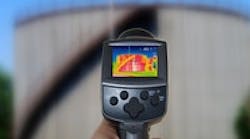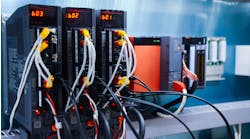An infrared (IR) scan of the motor buckets revealed overheated contacts. Nevertheless, the maintenance group at Ralston Purina's plant in Lancaster, Ohio, didn't plan any immediate action. A few days later, on a hot day in June, the boiler house motor control center (MCC) exploded.
[pullquote]
That's how crucial IR thermography is to maintenance. Even if you don't yet use the technology, you should appreciate its value. Applications include: checking the condition of gearboxes, motor bearings and coils, seals, steam traps, belt bearings, conveyors, electrical components (e.g., buses, fuses, disconnects, and hardware in a distributed control system, MCC controller or variable frequency drive) and rotating equipment, as well as detecting thermal and fluid leaks, material flaws and even liquid level.
IR guns and cameras are valuable because they're non-contact and don't demand prior knowledge of the range of temperatures expected. In contrast, a contact thermometer requires a range and may be inaccurate because of poor insulation or contact. IR measurement actually improves at high — I mean furnace high — temperatures.
A simple IR gun can be very useful and cost effective but only offers single-point measurement. A thermography camera provides a broader picture but is more expensive, which may rule it out for everyday measurement. For more on thermography, see: "Use Thermal Imagery for Process Problems."
IR isn't perfect. Its performance depends upon three critical factors: heat capacity, the inertia of the body to resist change, which is a common problem with any temperature measurement technique; proper orientation for radiation absorption — a poorly positioned thermocouple in a furnace can be off by 100°F; and, lastly, minimal variation in emissivity. As with any measurement, taking more readings will improve precision and reveal flaws in methods but probably also will widen the bell curve. Never take fewer than two or three shots with a gun.
A few tricks can help you get good measurements with a simple IR gun. For instance, find a well-insulated or relatively small hole (ideally, >3 in. deep) on the equipment you want to measure. Then, shoot that spot. Its emissivity will be about 1.00 and, because the IR radiation has nowhere else to go, you should get a good measurement. With insulated pipework and equipment, cut a replaceable flap around a nozzle or flange and shoot that spot. A useful trick is to put a piece of black tape on the surface you want to measure; the emissivity of black tape averages about 0.95. Use tape with a matte, not shiny, finish. Put the tape on at least a few minutes before taking a shot. Another useful target for IR is a red rust spot; emissivity is ~0.7 at 77°F. Always avoid shooting a reflective surface because its emissivity — and the reading — will be low; an emissivity below 0.2 makes measurement difficult. Here's one last trick: use a black surface of a known temperature to tune your gun.
Now, let's consider one of the most difficult applications — detection of steam trap failure. While most experts advise using an ultrasonic tester, IR can be useful with some types of steam traps — but not with inverted bucket traps because they generally fail open. IR can identify a plugged trap by detecting a difference between downstream and upstream pipes and the trap-feed and equipment-supply lines; in the latter case, if the difference is 20°F or more the trap has plugged. IR may be the only option for a trap that's in a hard-to-reach location because an ultrasonic tester must contact the trap.
For bearings in rotating equipment, perform a scan when the bearings are new, but not within a day of initial lubrication, to create a baseline profile. Then regularly monitor them. Treat a bearing running 100°F hotter than normal as failing.
As far as the situation at Ralston, the plant engineer probably was pondering how to deal with it when the fire occurred. The solution requires some finesse. (Don't send in a deck ape!) Copper contacts must be gently removed, cleaned and tightened, preferably with a torque screwdriver or wrench, although some electricians say finger tight works fine below 100 amps, i.e., 75 hp or below on 460 VAC. Afterward, it's good practice — with all specialty torque items — to keep a log and mark the bolt head with permanent ink.
IR guns offer an inexpensive qualitative means of involving your operators in day-to-day equipment troubleshooting.

DIRK WILLARD is a Chemical Processing contributing editor. He recently won recognition for his Field Notes column from the ASBPE. Chemical Processing is proud to have him on board. You can e-mail him at [email protected]
Latest from Automation & IT
Latest from Automation & IT

